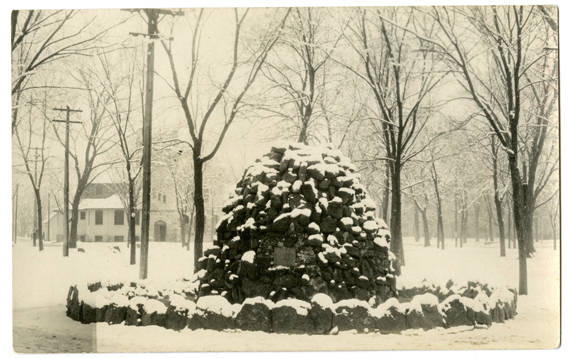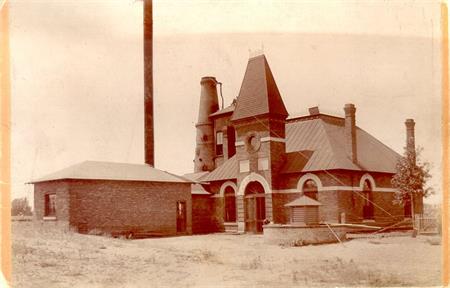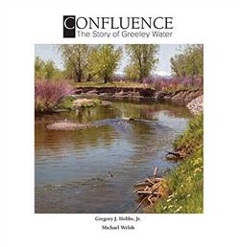Greeley was founded on land lying between the confluence of the Cache la Poudre and South Platte Rivers in April 1870 as a utopian agricultural and temperance community. As many considered this area of Colorado Territory a part of “the Great American Desert, water, which the Union Colonists would call “liquid gold” or “snow water” became its most valuable resource.
Greeley’s first “municipal source” of water came from the Cache la Poudre River, the Union Colony Ditch No. 3, and an aquifer underlying the town site, which allowed many residents to access potable water from shallow wells dug on their town lots. In addition, there was a community well. Obtaining good quality drinking water was a problem. Greeley’s founder, Nathan Cook Meeker, dug (by hand) a well 20 feet deep and three feet in diameter and lined it with wooden planks. Located behind the kitchen of his home at 1324 9th Avenue, Meeker complained by 1871 that his well water was hard, tasted of sulfur and water for washing the family’s clothes was carried in buckets from Ditch No. 3.
The Need for Clean Water
Outbreaks of typhoid fever, a disease contracted from drinking impure or contaminated water, was a perennial concern for Greeley and all communities prior to modern water and sewage treatment plants. Securing a reliable supply of uncontaminated and good-tasting water for the growing town (ca. 2,200 residents) became a priority in the 1880s. In 1883, a 1,200 foot deep artesian well  was drilled in the south half of Lincoln Park, and appreciative citizens now had access to free-flowing pure water, heralded for its quality and health-affirming properties. Unfortunately, the once-consistent flow of water diminished when seven other artesian wells, financed by private companies, were drilled in the downtown area. Today, the 1907 Pioneer Fountain in Lincoln Park marks the site of Greeley’s first artesian well.
was drilled in the south half of Lincoln Park, and appreciative citizens now had access to free-flowing pure water, heralded for its quality and health-affirming properties. Unfortunately, the once-consistent flow of water diminished when seven other artesian wells, financed by private companies, were drilled in the downtown area. Today, the 1907 Pioneer Fountain in Lincoln Park marks the site of Greeley’s first artesian well.
In the spring of 1888, municipal priorities included a new school, waterworks, and eliminating “tramps.”
The Greeley Public School was overcrowded, and a larger, modern school was needed; likewise, another critical need was a modern waterworks, but acquiring these amenities meant long-term financial obligations on the City and its taxpayers.
In addition, Greeley’s “tramp infestation” alarmed many citizens.
Mayor Charles A. White and Marshall Dave Camp spent evenings patrolling the streets, “rounding up” vagrants, and giving them the options of “overnight” accommodations in the City’s “calaboose” with “work assignments” the next morning, or the “freedom” to leave town immediately.
Most took the second option.
A Fresh Water Idea from Oregon
J.M. Wallace, president of Greeley’s First National Bank, had visited Salem, Oregon in June and was impressed with its waterworks and felt its design could be adapted to accommodate Greeley’s needs. Discussions about the feasibility of a new waterworks and its “price tag” continued throughout the summer. Mayor White became the chairman of a waterworks committee that visited other cities to inspect and compare the efficacy of various water systems. A public meeting at the Weld County Courthouse on September 29, 1889, was held to inform citizens and get their input. From a number of letters that appeared in the Greeley Tribune after this meeting, not everyone was in favor of the project. One individual, identified only by the initial “C,” stated many property owners were opposed to increased taxes, others had adequate soft water from their own wells, and some were investors in the artesian wells drilled throughout the City. The writer agreed that everyone was interested in the “. . . growth, success and reputation of Greeley,” but felt that a new waterworks wasn’t a guarantee against typhoid, which citizens could prevent by vigilantly keeping the “. . . alleys, streets, cesspools, and cellars clean.” Poudre water, “C” argued, was also “. . . impregnated with alkali and lime.” The writer also suggested a pipeline be built to access water in the mountains.
Now, How to Pay for It?
Other concerns were increased water rates.
In 1888, Greeley property owners paid .75 - $1.25 a season to irrigate a 50’
frontage lot, but the cost with a new waterworks could rise from $10- $15 for the use of water on an “. .ordinary 25’ front, without allowing the use of water to sprinkle the tree line on the sidewalk. “
In addition to paying interest on the bonds for a waterworks, some feared the 1888 water rates of $4- $6/year, might rise to $100 - $200/year.
Planning, however, continued and Mayor White’s waterworks committee decided a system similar to that used in Denver would be best suited for Greeley. An election was held on November 20, 1888, and 344 ballots were cast with 203 votes in favor of constructing the $65,000 waterworks with 144 opposed to the project.

Construction of the waterworks began in April 1889.
The City purchased 20 acres of land “near the western boundary of the city,” between Island Grove Park and the Greeley, Salt Lake and Pacific Railroad tracks.
An infusion well or “gallery” was dug into the gravel bed adjacent to the Cache la Poudre River.
Water from this original well was pumped and filtered through coarse gravel and sand to remove impurities before being pumped into the mainline, which delivered water from the plant to a 158,000-gallon standpipe (water tower) on Arlington Heights (Inspiration Hill on 20
th Street between 10
th and 11
th Avenues).
This line ran from the plant under the center of 17
th (Irving) Avenue to the intersection of 5
th (Oak) Street, then east under 5
th Street to 10
th (Adams) Avenue and then south on 10
th Avenue to the standpipe.
The standpipe, located at an elevation higher than the surrounding town, meant that gravity pressure allowed water to flow into adjacent water lines and homes hooked up to the municipal system.
The foundation for the 30’ in diameter by 30’ high standpipe was completed in June, and the standpipe itself was built in August.
It was made of 42,000 pounds of iron plates put together with 9,000 rivets.
The sides of the iron plates varied from 3/8” thickness at the bottom to 3/16” of an inch at the top.
A coat of asphaltum varnish and paint was applied to the exterior and interior of the standpipe.
Construction begins
In May 1889, workmen began digging trenches for Greeley’s 11.1-mile network of 4”, 6”, 8”, 10” and 12” diameter water pipes. Workers earned $1 for every 25’ section of the trench they dug. Many complained of the extremely hard ground that made digging difficult and once they reached the bluffs south of town, they stopped digging and demanded that the contractors increase their wages to $2 per 25’ section of trench.
Charles P. Allen, an engineer for the Denver Union Water Company, designed the Greeley Waterworks and supervised its construction, assisted by John D. Buckley, Greeley’s city engineer, who prepared the first map of the waterworks district of the City. The firm of Wyman and Smith built the pump house and Dave F. Camp had the contract for the brickwork. The brick buildings featured stone trim, and the main building, with its tower entrance into the pump room, was 32’ x 36’. The pump house was connected by “wire” (telephone) with City Hall for 24/7 communication between the city officials and the plant operator in the event of a fire or other emergency. The capacity of the pumps was 1 million gallons per 24 hours. The west side of the building had an apartment for the plant operator and his family. The boiler house was 18’ x 32’ and included a storage area that could hold three train cars of coal, hence the location of the waterworks near the railroad.
The
Greeley Tribune reported on July 3, 1889, that, “The waterworks are now working regularly from 7 a.m. to 9 p.m.;
when the water tower is completed the hours will be shortened, as the tower will hold sufficient for 12 hours, unless a large fire creates an extra demand when a telephone message will inform the engineer at the works, and the pumps will furnish the additional pressure, and whatever extra water is needed.”
The
Tribune also noted, “A slight accident at the waterworks on Thursday morning put a stop to the working of the pumps for a day.
The nightwatchman filled the boiler clear to the top with water, and when the fire was started, and the water got warm something “had to go,” and the short piece of a steam pipe in the top of the boiler was blown out by the pressure; consequently the rest of the pipe fell down on the roof.
But little damage was done.
Fred Dresser, the engineer, went to Denver for new couplings, and by Friday afternoon, everything was in order again, and the pumps started.
No further trouble has occurred.
The brick masons are now putting up the boiler house.”
A New and Improved Supply of Water
Within a few months, Greeley citizens had a new and improved supply of water. The successful completion of the Greeley Waterworks ended, however, on a somber note. City engineer John D. Buckley, who had worked closely with Charles P. Allen on the construction of the waterworks, became gravely ill, most likely from typhoid fever. On the evening of July 29, he took medicine prescribed by Dr. Mulford and went to bed. At 5 a.m. on July 30, Union Pacific engineer Ira Hughes spotted a barefoot man clothed only in a nightshirt and trousers lying beside the railroad tracks 300’ from his home. Hughes stopped the train, recognized the man as Mr.Buckley and with the help of Mr. Huffsmith, placed him on a board and carried him home. Buckley was conscious but unable to remember wandering from his upstairs bedroom and onto the tracks where he was struck by a 1 a.m. train, which severed his spine and paralyzed his lower body. Perhaps he was sleepwalking or disoriented due to the medicine he had taken. The doctors pronounced that Buckley’s injuries were fatal. He accepted his fate, attended to personal business matters, and died the following day.
John D. Buckley was a civil engineer who knew a lot about Greeley, especially its irrigation ditches. A member of the Union Colony of Colorado, he came to Greeley from New York in 1870. He assisted E.S. Nettleton, who became Colorado’s second State Engineer, with surveying and laying out the town lots, and the irrigation canals. Buckley surveyed the canal that diverted water from the Salt River in Arizona, and the Bijou Canal on the South Platte River. The Greeley Tribune, July 31, 1889, said this of Mr. Buckley: “As a citizen and a man he was highly esteemed; as a civil engineer, he was thorough and careful in his work, and in the surveys for the construction of irrigating canals he had few equals. His death will be universally regretted in Greeley and wherever he was known.”
Water Restrictions and Water Shortages
Due to the Panic of 1893 and several years of depression, the Greeley Waterworks operated at a deficit, and water shortages were a major concern during the summer months due to homeowners watering their lawns.
The City passed Ordinance 65 in May 1993, establishing set times for outdoor watering, along with fines ($5 - $300) for non-compliance.
By 1900, Greeley’s population was 3,023 and grew to 8,179 by 1910.
More water, a persistent theme in Greeley’s history, was needed.
In 1901, Mayor Henry C. Watson would work tirelessly to inaugurate Greeley’s next source of municipal water -- a pipeline to the mountains -- as suggested by a letter to the editor of the
Greeley Tribune in 1888.
But that is another story.
For those interested in learning more about the  significance of water in Greeley’s history, you are in luck! Confluence:The Story of Greeley Water, by Gregory J. Hobbs, Jr. and Michael Welshis available on Amazon.
significance of water in Greeley’s history, you are in luck! Confluence:The Story of Greeley Water, by Gregory J. Hobbs, Jr. and Michael Welshis available on Amazon.
Prepared by: Peggy A. Ford Waldo
March 5, 2020